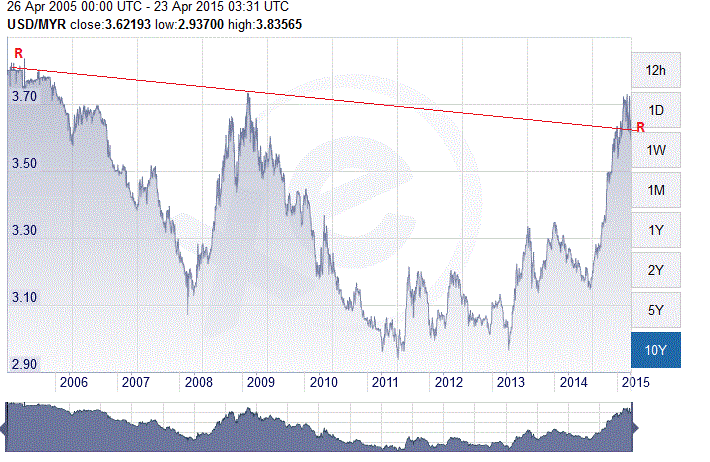Masteel has just
announced yesterday that it will not be able to comply with Bursa's Listing Requirement is that all listed companies must "furnish its Annual Audited Financial Statements ("AFS") for the
financial year ended 31 December 2014 ... for public release within a period not exceeding four (4) months
from the close of the financial year (“Relevant Timeframe”) which falls on 30
April 2015".
If Masteel "fails to issue the outstanding AFS 2014 within five (5)
market days after the expiry of the Relevant Timeframe... Bursa Securities shall
suspend trading in securities of the Company on 12 May 2015".
If Masteel "fails to issue the outstanding AFS
2014 within six (6) months from the expiry of the Relevant Timeframe... Bursa
Securities shall commence de-listing procedures against the Company."
However, Masteel "expects its AFS 2014 (to be ready) on or before 11 May 2015,
although the Company is working towards the deadline on 30 April 2015".
Technical Outlook
We
can see that Masteel broke its long-term uptrend line, SS at RM0.90 in January this year. It has just broken the tentative support line, AB at RM0.75. I see support at the horizontal lines at RM0.70, RM0.60 & RM0.55. (As at 10:15am, Masteel was trading at RM0.695.)
C
hart: Masteel's monthly chart as at April 27, 2015 (Source: ShareInvestor.com)
Account Analysis
It is hard to put any faith in the account of Masteel presently. Nonetheless, we do not have anything else to go on at this point of time.
From Diagram 1 (Cash Flow statement for the past 9 years), we can see that Masteel has generated decent Cash Flow from Operating Activities. The Cash Flow used in Investing Activities has been consistently high and exceeded Cash Flow generated from Operating Activities. The shortfall was covered by Cash Flow generated from Financing Activities (or bank borrowings).
When you compared the 10 years' Profit & Loss account of Masteel and Annjoo, you would notice that Masteel has been profitable for the past 3 years while Annjoo- one of the best managed steel producers in Malaysia- was only breaking even. And, yet you would notice that Annjoo was not adding new Fixed Assets, unlike Masteel. That could be a clue.
 Diagram 1: Masteel's 10 years' PL & CF (Source: ShareInvestor.com)
Diagram 1: Masteel's 10 years' PL & CF (Source: ShareInvestor.com)
 Diagram 2: Annjoo's 10 years' PL & CF (Source: ShareInvestor.com)
Diagram 2: Annjoo's 10 years' PL & CF (Source: ShareInvestor.com)
I have appended below Masteel's Balance Sheet as at 31/12/2014 & 31/1/2009. I extracted the Balance Sheet for 31/12/2014 & 31/12/2008 and studied the changes in the Balance Sheet. Thee main changes are as follows:
- Fixed Assets (Properties, Plant & Equipment) increased by RM138 million (net off Prepaid Lease Payment) & Debtors rose by RM197 million.
- Retained Profit rose by RM109 million.
- Short-term Borrowings rose by RM151 million while Long-term Borrowings dropped by RM90 million.
- Creditors rose by RM137 million.
Over 7 years period, Masteel's financial position has deteriorated with Current Ratio dropping from 1.8X to 1.2X while gearing ratio increased from 0.7X to 0.9X. Working capital requirement increased due to longer debtors collection period (from 56 to 83 days)
& longer inventory holding period (from 63 to 87 days).
(Note: Inventory holding period dropped from 76 days to 43 days).
 Table 1: Masteel's Balance Sheet as at 31/12/2014 & 31/12/2009
Table 1: Masteel's Balance Sheet as at 31/12/2014 & 31/12/2009
 Table 2: Masteel's Balance Sheet as at 31/12/2014
Table 2: Masteel's Balance Sheet as at 31/12/2014
 Table 3: Masteel's Balance Sheet as at 31/12/2009
Conclusion
Table 3: Masteel's Balance Sheet as at 31/12/2009
Conclusion
At this moment, we can only say that Masteel's financial position as reported has deteriorated over the years. It has been operating in the competitive steel sector which has been weighed down by cheap import from China. That Masteel was able to record a profit over the past few years had been a feather in the cap for the company. The delay in submitting its AFS has been a real blow to its shareholders. I personally hope that this is not a serious violation and Masteel will be redeemed itself in the eyes of Malaysian investors soon.
Note:
In
addition to the disclaimer in the preamble to my blog, I hereby confirm
that I do not have any relevant interest in, or any interest in
the acquisition or disposal of, Masteel & Annjoo.



















































